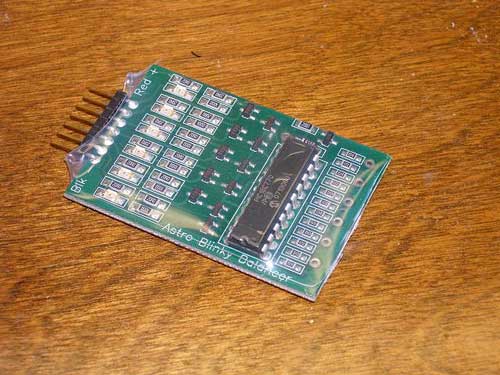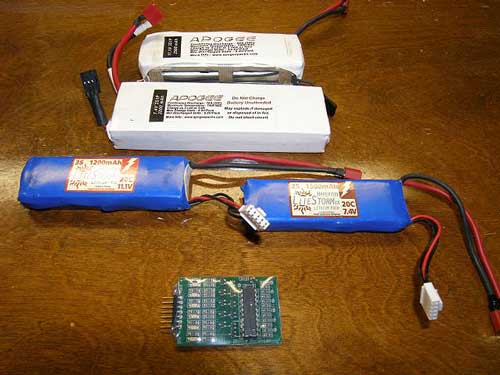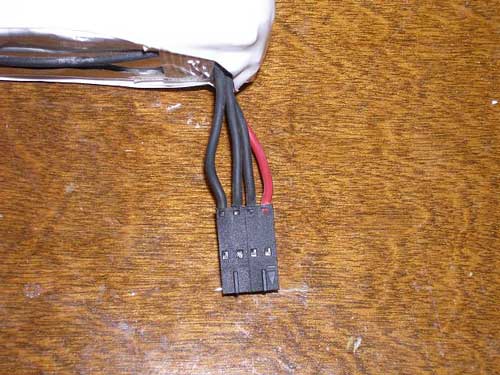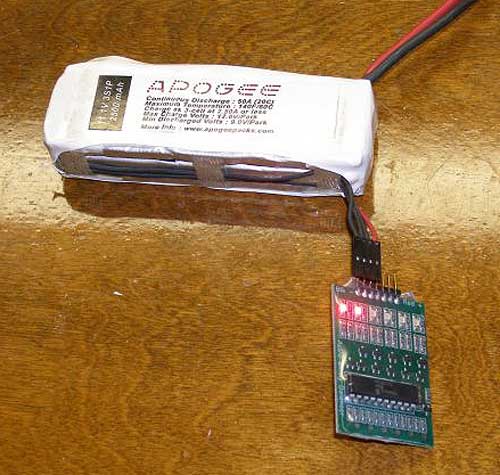|
 THE RUN DOWN : The Astroflight "Blinky" is
a LiPo battery pack balancer.
It balances packs during or after charging, ensuring that you are able
to fit the most mAh safely into your packs.
THE RUN DOWN : The Astroflight "Blinky" is
a LiPo battery pack balancer.
It balances packs during or after charging, ensuring that you are able
to fit the most mAh safely into your packs.
I've been running LiPos for around a year now, and I absolutely
love 'em! Nothing beats the power density, light weight and
flat discharge curve that they offer. They are a bit more expensive
though, so it makes sense when people ask me "do I need
to balance my LiPo packs?"
Well, I hadn't ever balanced a pack and hadn't had a problem, so I told
folks that it generally wasn't all that necessary. Besides, at the time
I didn't have any real expensive packs, so if one tanked on me, it
wasn't that big of a deal to replace it...they were all for my RC18T.
 Well, as time goes by, I've got a few more brushless rigs now. I've
also started getting a collection of LiPo packs that are more expensive,
so I started thinking more about balancing. I wasn't particularly
worried, but it was always in the back of my mind. After Squirrel put
his Blinky up for sale (and I missed buying it by one day!) I decided
I
needed one.
 Why do you need to balance?: By nature, all cells are different in
the
way they take a charge and discharge. With NiMH, you can do a slow
discharge and slow charge to rebalance the pack. You could conceivably
do that with LiPo too, but with the capacities out there now, it would
take forever, not to mention that LiPo's just a few tenths of a volt
out
can negatively impact charge performance. For instance, say you have
a
3S pack. You have one cell that's low, and the other two are normal.
When you peak charge the pack, the charger will stop when those two
cells are charged, and the one cell that's low won't get a full charge.
With NiMH, that's not a big deal, but with LiPo you could potentially
have a problem. As we all know, over discharging LiPos is a Bad Thing.
The opposite can happen if you have two cells that are low and one
that
is high. The charger may overcharge the high cell, because it's being
masked by the two low cells. Again, another Bad Thing. This scenario
is one of the reasons I charge in a fireproof enclosure. Of course,
it
may just terminate the charge early, leaving you with one properly
charged cell, and two undercharged cells. Any way you look at it, if
you don't have a balancer running, you most likely aren't getting the
full capacity that you paid for. However, with a Blinky, these problems
pretty much go away!
The Blinky is a very simple device. It's packaged in much the same way
as the Eagletree is; a clear shrink wrap tube. The packaging here doesn't
really bother me nearly as much, as it's not intended to be put in a
vehicle, it just sits on your bench. The pin spacing is 0.1" and
the pins are 0.025" square. If your balance plugs fit that, you
won't have to make any changes. If not, there are adapters available
for it. It just so happens that Apogee uses that exact spacing and pin
size. Hyperion does too, but the pin layout of their balance plug is
not the same as what the blinky wants to see. They skip a pin in their
sequence, and that's not compatible with the Blinky. No worries though,
as a quick poke with a sharp point and you can pull the pin out and slide
it over one notch. As long as you have all the wires together with no
skips, you'll be good to go. It should look like this when you are done:
 Alright, the plug is set, and you're ready to go. Now what exactly
does this thing do? Well, it has 3 functions:
It does a low voltages check on the pack when you plug it in. If you
have a 3S pack, you should see 3 solid lights when you plug it in.
If
you are missing a light, then you have a very low cell, and you need
to
start your charge at 0.1 amps until you get a light. This keeps you
from damaging your pack.
It balances while charging. After the above check, you charge the
pack
normally. Once one cell reaches 3.9v, balancing starts. By the time
the charge is finished, the pack will be balanced. Whenever you see
a
light on, it means the Blinky is discharging that particular cell.
Once
all the lights are out, your pack is balanced.
It balances after charging. This is only used if you hadn't balanced
while charging, or if you didn't want to balance while charging. The
balancer will begin discharging every cell that has more than 4.25
volts. When all cells are 4.25 volts or less, then the balancer will
begin balancing to the lowest cell. When all the LED’s turn off
or
occasionally blink at random, then the pack is balanced.
This is what you'll see when it's working:
That's pretty much all there is to it. I use it every time I charge
now, mainly because it's easy, and with the pack balanced, the charge
won't terminate early. I'm sure to get all the mAh that I can fit in
there. Since it does it while it's charging, it doesn't add any extra
time, it's just a plug and go operation. It couldn't be any simpler. At
$23 from Tower,
it's another inexpensive addition to the
pit box.
NOTE FROM THE EDITOR: Review
written by "Sleebus.Jones", long time BYT Forum Moderator and BYT
Web Site Contributor. Sleebus is based in Texas and is an excellent source
of RC knowledge, especially in the world of electronics. We are glad to have him as a part of the BYT Team.
Thanks for the great write-up Sleebus!
|




